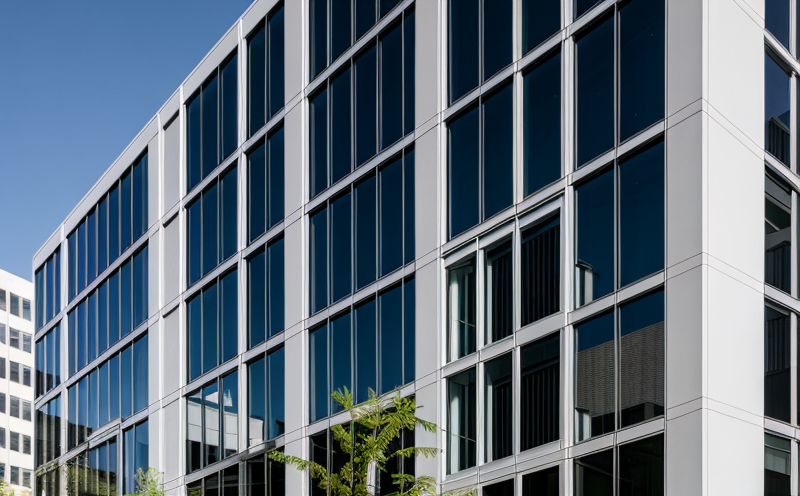EN 12150 Safety Glass Testing
The European Standard EN 12150:2017 specifies the requirements and methods for safety glass used in building construction, particularly focusing on laminated safety glass. This service ensures that glass products meet stringent safety standards to protect against potential hazards such as impact or fragmentation.
This standard is crucial for ensuring public safety by preventing accidents caused by broken glass. It applies to various types of buildings including residential homes, commercial offices, schools, and industrial facilities where safety glass is required. The tests are designed to simulate real-world conditions under which the glass might be exposed during use.
The scope of EN 12150 includes:
- Impact resistance testing
- Edge strength evaluation
- Cutting edge impact performance assessment
- Thermal shock resistance measurement
To perform these tests, we use specialized equipment such as ball drop machines for impact resistance and thermal shock testers for evaluating the glass's response to sudden temperature changes. Preparing specimens correctly is critical; this involves selecting appropriate sizes based on intended application.
| Test Type | Description | Equipment Used |
|---|---|---|
| Impact Resistance | Evaluates the glass's ability to withstand impact without shattering. | Ball drop machine |
| Edge Strength Evaluation | Metric for measuring the strength of a glass edge after cutting and grinding. | Tensile testing machine |
| Cutting Edge Impact Performance Assessment | Determines how well the glass resists damage from sharp objects along its edges. | Sharp object impact tester |
| Thermal Shock Resistance Measurement | Assesses the glass's resilience to rapid temperature changes, which could be due to extreme weather conditions or sudden exposure to heat or cold. | Thermal shock tester |
The results of these tests provide critical information about the performance characteristics of safety glass. Compliance with EN 12150 ensures that building materials are safe and reliable, contributing to overall structural integrity and occupant protection.
Our laboratory adheres strictly to this standard when conducting safety glass testing services. Our team comprises experts in materials science who possess extensive experience in interpreting test results accurately. By leveraging advanced analytical techniques and state-of-the-art facilities, we deliver precise and actionable insights into your product's performance.
Scope and Methodology
The scope of EN 12150 includes the testing requirements for safety glass in building applications. This encompasses both laminated and toughened glass types. The methodology involves several key steps:
- Sample Preparation: Specimens are cut to dimensions specified by the standard.
- Impact Resistance Testing: Samples are subjected to impact from a steel ball dropped from various heights depending on the glass thickness.
- Edge Strength Evaluation: Tensile tests measure the strength of edges after cutting and grinding processes.
- Cutting Edge Impact Performance Assessment: Sharp objects are used to simulate real-world scenarios where sharp fragments might pose a risk.
- Thermal Shock Resistance Measurement: Samples undergo rapid temperature changes using specialized equipment like thermal shock testers.
The methodology ensures consistency and reliability in test results, which is essential for quality assurance and regulatory compliance. Our laboratory uses cutting-edge technology to ensure that each step of the process adheres strictly to EN 12150 standards.
Industry Applications
| Application Area | Description |
|---|---|
| Residential Construction | Ensuring windows and doors meet safety standards for homes. |
| Commercial Buildings | Guaranteeing the structural integrity of facades in office complexes and shopping centers. |
| Schools & Universities | Achieving compliance with safety regulations for educational facilities. |
| Healthcare Facilities | Maintaining patient and staff safety in hospitals and clinics. |
| Industrial Environments | Safeguarding workers in factories and warehouses against potential hazards from glass fragments. |
The EN 12150 safety glass testing service is particularly important for ensuring that glass used in these applications meets stringent quality and safety requirements. Compliance with this standard helps prevent accidents, injuries, and property damage caused by broken or unsafe glass products.
Environmental and Sustainability Contributions
- Eco-friendly Materials: Using recycled materials in the manufacturing process reduces waste and conserves resources.
- Energy Efficiency: By enhancing building insulation, safety glass helps reduce energy consumption for heating and cooling.
- Reduction of Waste: Properly manufactured safety glass minimizes the risk of breakage during installation or use, thus reducing post-consumer waste.
The EN 12150 safety glass testing service not only ensures compliance with international standards but also promotes sustainable practices within the building and construction industry. Our commitment to sustainability extends beyond just testing; we work closely with clients to identify opportunities for integrating environmentally friendly practices into their projects.





